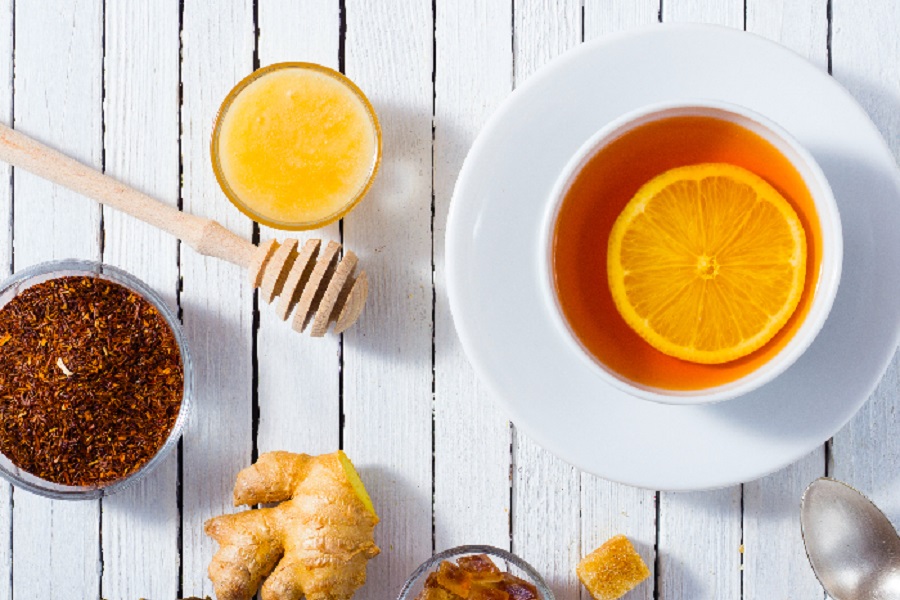Decaffeinated or herbal tea is a beverage made by steeping the roots, stems, bark, seeds, leaves, fruits or flowers (dried or fresh) of plants in hot water. They are naturally caffeine-free, and some of the plants used to make them include hibiscus, peppermint, rooibos, and ginger, among others. These herbal infusions are also called tisanes.
There is no doubt that the trend for high quality decaffeinated or herbal teas has exploded all over the world. You can find exotic blends on the market such as sweet berries and chocolate roses, dried apples and cinnamon, spearmint mixed with turmeric and lemongrass, and more. You can even brew your own decaffeinated tea with your favorite herbal ingredients. Some specialty teas may contain chocolate, which does contain caffeine. Therefore, it is best to look at the “decaffeinated” label when purchasing.
Decaffeinated Tea vs Decaf Tea
Traditional tea is made from tea leaves and the buds of the Camellia species. They contain caffeine, a natural stimulant. People who are sensitive to caffeine but want to drink traditional tea can choose decaffeinated tea, which is different from decaffeinated tea. Decaffeinated tea is a type of tea that has undergone a process that is almost completely decaffeinated.
Chamomile Relaxation Tea
Research reports that the most popular use of chamomile as an herb comes in the form of tea—more than a million cups of chamomile tea are consumed in a single day. The dried flower of chamomile is one of the oldest herbs used to treat inflammation, muscle cramps and hay fever, as well as insomnia. You can drink chamomile tea anytime during the day or just before bedtime to relax.
Peppermint Tea Refreshing
Peppermint tea is a popular herbal and caffeine free tea that is favored as a refreshing hot beverage. It can be drunk as morning tea or eaten with meals – it’s a natural breath freshener. A study published in the New York Times Phytotherapy Research The Wall Street Journal revealed that peppermint tea has significant antiviral and antibacterial properties. It’s also a natural way to reduce headaches and pain in the gastrointestinal tract because of its pain-relieving effects on the body.
Antioxidant Tea Bag
Enjoyed by the people of South Africa for centuries, rooibos tea is rich in antioxidants and flavor. It has a grassy taste with a hint of citrus and is even better with tart toppings like lemon or orange slices. The health benefits of drinking rooibos tea include reducing irritability, tension headaches, and insomnia.
Lemon Ginger Tea for Healthy Digestion
Lemon-ginger herbal tea has traditionally been used to relieve stomach pain and nausea. Both lemon and ginger contain natural oils and antiemetic biological compounds that prevent vomiting and soothe the stomach. Lemon Ginger Tea with Honey is a great option to help tame the stomach and aid in healthy digestion.
Warmed Spice Tea Can Relieve Colds and Coughs
In Ayurveda, spices like cinnamon, cardamom, cloves, pepper, and nutmeg are considered warm spices. When the weather gets cooler, drinking a cup of herbal tea brewed with whole spices can promote healthy body warmth. These spices are natural expectorants and help relieve symptoms of colds, coughs and bronchitis.
Echinacea Tea Boosts Immunity
Echinacea In Europe and North America, this preparation is widely used to boost immunity and treat the common cold. According to the National Institutes of Health, taking echinacea can help shorten the length of time you are sick. Echinacea is often combined with other herbs such as lemongrass or peppermint to make it more like a herbal tea.
sage tea anti-inflammatory
Sage tea is a traditional remedy for the mouth and throat inflammations, coughs, colds, bronchitis, asthma and many other health conditions. A report published in the Journal of Traditional and Complementary Medicine suggests that sage has antibacterial and antifungal properties due to its high antioxidant and flavonoid content. You can make sage tea at home by steeping fresh or dried sage leaves in hot water.


